Are you familiar with turkey work? Turkey work, also known as ghiordes knot, is an embroidery technique that can be used to created a fluffy piled clump (for lack of a better word!) anywhere you want one on your embroidery. The technique is used a lot in stumpwork, but it can also be used in other needlework techniques. Turkey work makes great squirrel tails! Like this one, stitched by my sister:
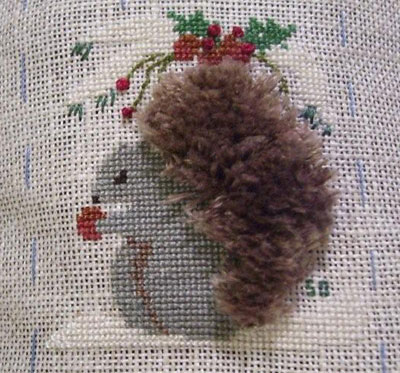
The other day, I was demonstrating turkey work to a fellow stitcher, and we got to talking about Fluff and how to achieve it. I’ll show you what I showed her. This isn’t so much a demonstration on doing a stitch, as much as it is a discussion of fluffing the stitch, so if you’d like to see how turkey work is worked, check out my turkey work video. You’ll see that it’s a Really Easy Stitch – nothing more than a loopy backstitch, really!
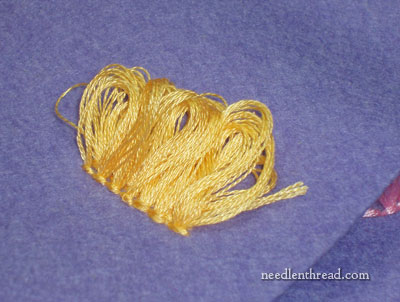
I’m working here on felt, using regular six-stranded embroidery cotton, and I’m using all six strands. When doing turkey work, you don’t have to use all six strands – that’s up to you – but you’ll achieve better results, I think, if you use three or more strands of floss, unless you’re doing tiny delicate work, and then you might use two strands. If you use all six strands, you can use a #5 embroidery needle to accommodate the bulk (and you can even get away with a #7 if you need to).
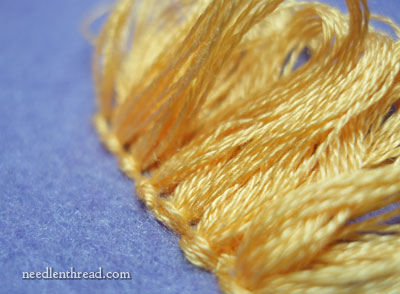
You can see that the stitch produces long loops of the thread that are held in place by these “locking” stitches, which are simple backstitches.
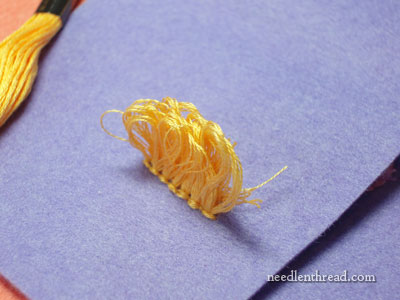
After you’ve filled the area that you want to be fluffy with rows of turkey work, you can use your fingers to smooth the threads together and make them stand up on the fabric. Time for a hair cut…
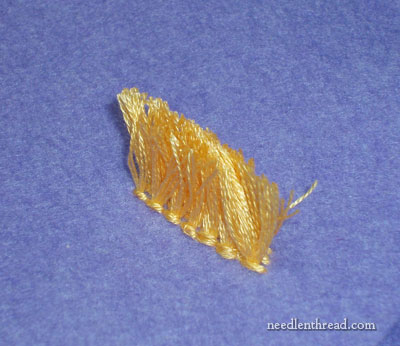
Now, sometimes you might not want to trim off the loops – it depends on what look you’re trying to achieve – but most turkey work is seen fluffy, and so the tops of the loops need to be trimmed off to achieve this.
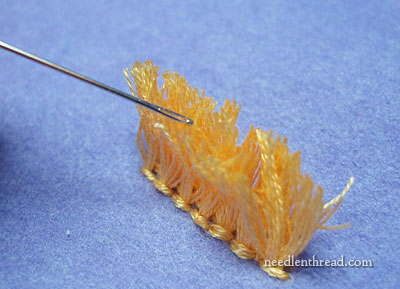
At this point, if you want a very long pile, you can fluff the stitches with the eye of your needle, by running the eye through the stitches. But mostly, turkey work is “sculpted” and trimmed to achieve a certain fluffy shape. So start by fluffing a bit, and then trim a bit. And the eye of your needle can suffice to do this – you just have to keep working it through the pile. But if you want a more efficient way of creating fluff, you can use this spindly monster:
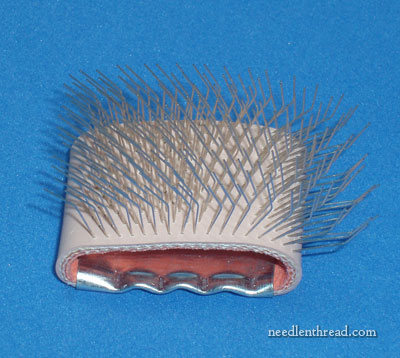
This is a nap brush. It’s used to lift pile. You can use it to comb velvet. You can use it to fluff turkey work.
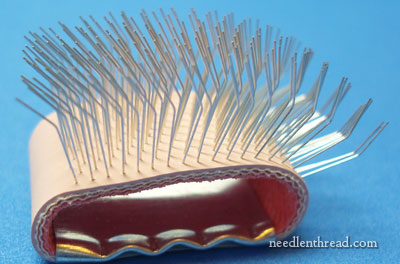
It’s rather a vicious looking thing, isn’t it? But all those little wire prongs there do the job of fluffing much better than the eye of an individual needle.
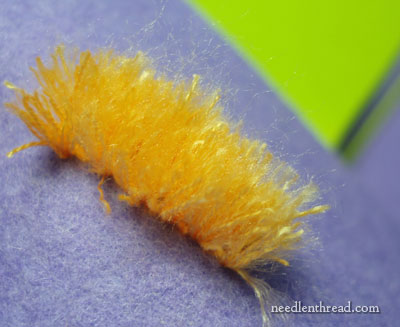
This is looking a little fuzzy and fluffed after a first combing with the nap brush. Perhaps a bit too fuzzy – it needs a little trimming.
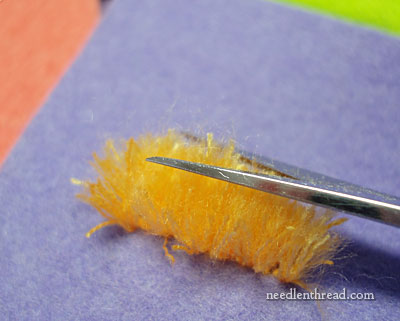
After combing through the turkey work, take your fine embroidery scissors and carefully cut a little bit from your pile. Trim and sculpt in tiny increments – be careful! It’s a lot easier to take tiny bits off than it is to restitch your turkey work if you hack it all away in one swipe! (My dad has that problem when he trims hedges…..)
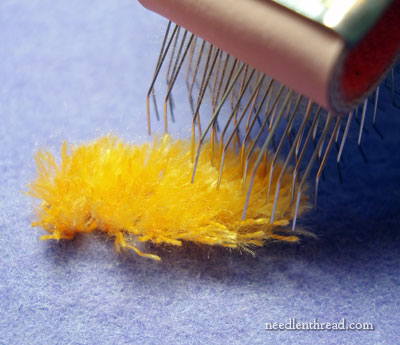
After you trim a little, go at the pile again with the nap brush. If you need to, you can trim and sculpt again…
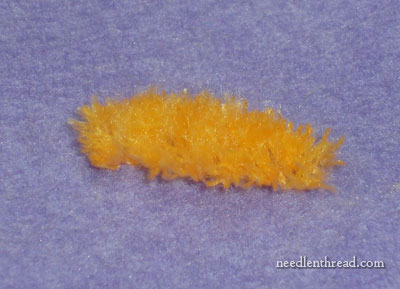
… and you’ll end up with a nice fluffy mound of thread, perfect for whatever element you want fluffed up on your embroidery. Are you stitching thistles? Try turkey work! What about a fuzzy caterpillar? Or how about the yellow “beard” on an iris leaf? A fluffy teddy bear? Or a cute baby chick? Ohhhhh, the possibilities!
So if you’re looking to add a little fluff to your needlework, try turkey work. And if you’re planning on doing quite a bit of stumpwork or adding fluff to your other surface embroidery projects, if you can get a hold of a little nap brush from your local needlework shop, it’ll make fluffing fluff fun!
Have a fantastic Friday!







I LOVE that squirrel. Well, I should since I made it! I have a little tip for you to pass on to your readers if you want. That same pile brush you probably bought is the exact same kind of brush for de-shedding a dog! So you could kill two birds with one stone. Fluff the Turkeywork and de-shed the dog. You are making me want to go back to embroidery. Now I wonder what I should make with that squirrel. Hmmm.
Hi, All –
Thanks for your comments on the fluff!
Concerning the nap brush – it’s about 1.5″ x 1″ – so it may not be the same size used on your pets – though I suppose you could use it on your pets, for a really long de-shedding session! 🙂
I really want to do something fun with turkey work this summer – I just don’t know what…!
That nap brush looks a LOT like the brush I use on my cats.
That is so cute!!
…. that’s the turkey work … not the nap brush which, as you say, looks rather vicious!
[It’s been a while ;-)!]
I love this stitch!!!! Many applications, versatile indeed!!!
I like how it looks both ways… before and after.
you make this look so attractive…i may have to try this for the center of some flowers, or maybe use different colors to get the stripe on a bee….do you think an old toothbrush would work?
ktj
Usually I look for ways to add sparkle to my work, either with beads or filament/braid. Now I’m going to be looking for ways to fluff up my work. And I’ll be looking for more patterns that could use a bit of fuzz. Oh dear, just what I need. . .. more patterns. LOL
It would be a good stitch for the body of a bumble-bee.
You could then make bumble-bee brooches; sure that children would love them 🙂
Hi Mary, I LOVE turkey work and use it a lot in stumpwork. I don’t have a nap brush (where did you find yours?). I use an eyebrow comb that I bought at the drugstore. I know it sounds weird but it does work.
Dear Mary
I love the tail it gives me ideas for future designs.
When I designed a card for a friend of mine from one of your monogram patterns, I looked on your website on how to videos and used the tukey work as part of a design for a tiny flower and when finished I cut it very small it looked quite good and my friend was really pleased with the overall design of the card.
Take care
Anita
Dear Marymentor:
You have been so helpful and kindly patient with your advice that I thought I’d pass this one along. While (thanks to your tutelage) I’m pretty good with the ghiordes knot and have used it in my stumpwork the nap(Bunka) brush, I saw here and said “Yes ! I MUST have that”. Searched the internet and just now found one on Ebay for $6 and change, shipping included, if anyone else is interested.
PS. There were other sites, but some of them wanted $9 shipping for a $6 brush. Thanks again…Judy in Pittsburgh
Thanks for a lovely demo.The stitch is beautiful.
I have a piece of fabric with a raccoon outline printed on it languishing it the stash. I never could figure out what to do it in, other than wool. Maybe turkey work would be good for it’s body? How quickly does turkey work progress?
I should clarify – how quickly does the stitching progress? I realize that the fluffing/trimming would vary greatly depending on how much you fluff & trim off at a time.
Hi, Gail – It’s a really quick stitch – like backstitch or stem stitch, but you have to hold the loop in place while you take the locking stitch. But it goes pretty quickly! ~MC
I love the squirrel. It really is an easy stitch for something that adds so much character. I used your tutorial video to learn the ghiordes knot for some willows I was working on, and it turned out great!
Hi Mary,
Great tutorial! I bet Ghiordes knots would work really well with tonally variegated floss. And since I have piles of the stuff (somehow I’m unable to resist it even though I know solids will look better in use), I expect I’ll be doing a fair bit of it.
Cheers,
Jen
A small slicker brush for cats will do wonders–and make the cat very happy, too. 🙂
The other cheap version is a file-cleaning brush from the tool department at Home Depot or Lowes’ etc.. Just be CAREFUL to use it only on what you want fluffed, ’cause those file cleaners can really do a job on your fabric by mistake!
The soft slicker brushes, not so much, especially the little triangular ones for tight spots. 🙂
Mary I used one of these brushes for needle punch back in the 80’s. I know they can still be found on sites where they sell needle punch supplies.
Where can I get a nap brush or the fluff brush?
Thanks.
You can find them through Nordic Needle, here: http://www.nordicneedle.com/prod/6749.html Hope that helps! ~MC
Thank you so much for posting this. I had no idea this was a thing. My cat recently passed away and I only ever have done normal cross stich. After finding this site I want to make something dedicated to him including ribbon embroidery and this tufting technique. Thank you
This is a very interesting technique and has a very similar outcome to brushing in Bunka Embroidery. While stationed in the early 80s in Northern Japan, I learned the technique of Bunka. I am currently working on two Kabuki dancers and they have a lions main that will require a brushing technique. The needle work is done on the back side of the canvas. It requires a 1/16 inch stitches and when the designated area is completed; the right side of the canvas is brushed out with the same pronged brush as shown in the above picture on this page (Embroidery Fluff). This brushing technique in Bunka can give you a pile stitch, a fluff and depending on how you trim for special effect; your results can also give you a mohair or velvet look by trimming with scissors. Just depends on what you are looking for in results for your embroidery art.
I will add this to my stitching diary (tips) for future embroidery work. Very nice and the little squirrel is cute. The Turkey stitch adds a great touch, thank you.
Thank you so much for your excellent article on how to make things look fuzzy through turkey work. It was a fun read with great pictorial references!